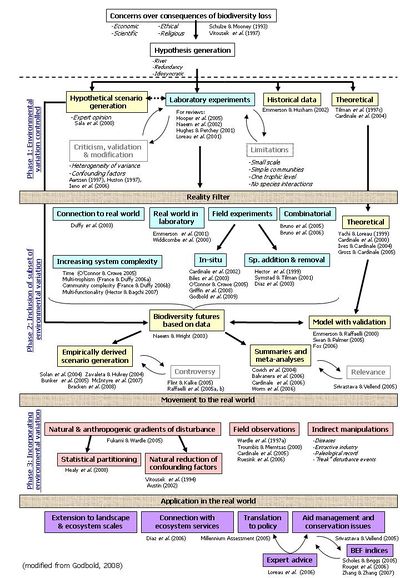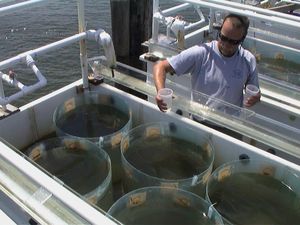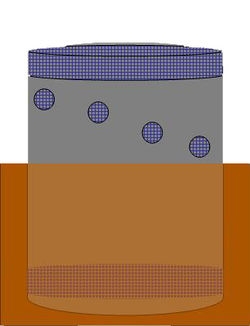Biodiversity and Ecosystem function
Contents
A review of biodiversity-ecosystem function research
Human needs and actions have, and will continue to, extensively alter ecosystems and biodiversity on a global scale [1]. Predictions of changes in biodiversity, not only in marine, but also terrestrial and freshwater ecosystems [2], have raised substantial concern over the consequences of biodiversity loss on ecosystem processes and function, which subsequently affect the provision of ecosystem goods and services, and ultimately affect human well-being [3].
Since the early 1990’s a portfolio of evidence obtained from the development of theory, laboratory experiments, field experiments and observational studies has shown that, irrespective of the system under study, increasing biodiversity tends to have positive effects on ecosystem properties, although the pattern of response may vary depending on the ecosystem and species investigated.

Emergence of a new paradigm
The central thesis that guided early community ecology saw patterns in the distribution and abundance of species merely as an expression of the abiotic (chemical and physical) and biotic (species interactions) components of the environment, giving a predictive understanding of species distribution and abundance within ecosystems [4]. In the early 1990’s, however, an increasing number of ecologists began to challenge this view and, instead, started to examine, how ecosystem properties are mediated by the biota [5]. A wide range of hypotheses were developed describing the form of the biodiversity-ecosystem function relationship and which collectively formed a framework within which this relationship could be tested experimentally [6].
In a series of phases, biodiversity-ecosystem function research has steadily improved to make experimental designs and model predictions more realistic (Figure 1). The timing of publications from each phase shows that, although different approaches have been used within the biodiversity-ecosystem function framework almost since the first influential paper was published in 1994 [8], there has been a general trend for experimental and theoretical studies to incorporate more natural environmental complexities (Reality filter, Figure 1).
Phase 1 - Laboratory experiments
Initially, biodiversity-ecosystem function relationships were investigated by manipulating biodiversity under controlled conditions in the laboratory (Figure 2a) [12, 13]. In such studies, simple, single species communities are randomly assembled and their effects on ecosystem function determined. Then diversity is increased by constructing multi-species assemblages comprising the single species that have already been characterised and the effects of these multi-species assemblages on ecosystem function is determined (Figure 2b). If the observed response of the multi-specific assemblages differs from the response predicted by summation of the single species responses, then it is concluded that diversity has had an effect.
Although these experiments successfully articulated biodiversity-ecosystem function hypotheses and allowed for the unambiguous interpretation of cause-effect relationships, critics were quick to assert that such studies lack realism because they tend to only include a few species (representing only a subset of the total community), often only from one trophic level, and they invariably assume that species loss is random. In addition, these types of experiments attracted further criticism because ecosystem function is measured infrequently and in the absence of the appropriate environmental context, thus making applicability to the real world questionable [14].
Despite debates over experimental designs and applicability, syntheses of the available evidence suggest that, irrespective of the system studied, increased biodiversity tends to have a positive effect on ecosystem properties, such as primary productivity, nutrient flux and decomposition, but the pattern of response varies depending on the ecosystem and species investigated [15, 16]. This variability between results suggests that ecosystems respond differently to biodiversity loss, as natural ecosystems are complex, open systems that are composed of interconnected gradients, patches and networks between, and within which, organisms move and interact [17]. The high degree of control required in experiments and the short time periods under which they are conducted means, however, that the environmental variation and biological interactions that occur in natural systems are largely controlled for. The inherent complexity of environmental systems resulted in increasing calls to incorporate more environmental realism into experimental designs [13, 18] as it is still unclear whether the currently observed patterns in the biodiversity-ecosystem function relationship will hold, for example, for realistic extinction scenarios, in multi-trophic communities, and over larger spatial and temporal scales (14, 19).
Phase 2 – Inclusion of a subset of environmental variation
Diversity manipulations in outdoor mesocosms [Figure 3, 20] are subjected to natural fluctuations in light, temperature and rainfall and thus represent better analogues of natural systems than more controlled laboratory conditions.
In-situ experiments or species addition/removal field experiments have been particularly valuable for determining biodiversity effects under naturally fluctuating environmental conditions (Figure 1)[21-23]. These experiments largely involve synthetically assembled communities in plots, mesocosms (Figure 4) or mesh-bags, in which biodiversity is controlled, but natural fluctuations in, for example, tidal cycles, rainfall or temperature, occur (Figure 4c). Although such studies incorporate more environmental variation, the spatial and temporal scales of the experimental designs largely do not relate to the dynamics of the study organisms, particularly in terms of their size or generation time. One way to incorporate such population dynamics at small and large scales is to adapt elements of meta-population theory [24]. In such studies, the importance of dispersal, the mechanism that regulates and maintains species coexistence (especially in fragmented habitats), in mediating the biodiversity-ecosystem function relationship, is recognised. At the same time, theoretical models have been extended to include environmental fluctuations [25].
Most biodiversity-ecosystem function studies, use only a subset of the natural community to construct gradients of diversity, often selectively choosing those species that are either highly abundant or that may give the greatest response [18]. A move away from random extinction scenarios has relied primarily on modelling approaches to predict the consequences of diversity loss [26, 27]. The derived scenarios use extinction drivers that are explicitly associated with trait-based extinction probabilities and thereby provide a more direct way of assessing the possibilities of ecosystem responses to biodiversity loss. Such modelling approaches have the potential for exploring the consequences of biodiversity loss at greater spatial and temporal scales by making use of large data sets which are already available for many marine and terrestrial areas [19].
Phase 3 – Incorporating environmental variation
Despite the fact that there has been a steady increase in complexity of experimental and theoretical investigations of the biodiversity-ecosystem function relationship, it is still not clear whether the same patterns observed in experimental systems are just as strong and clear in natural systems. Studies based on field observations (Figure 4), have given some insight into the biodiversity-ecosystem function relationship in natural systems [28-30], however such studies are generally correlative in nature, lack direct experimental control and do not allow for replication. In addition, the inability to control confounding factors restricts the determination of cause-effect relationships between biodiversity loss and ecosystem function [28-30]. Despite efforts to overcome such problems (e.g. selecting sites of similar abiotic conditions, 28; or collecting data on additional environmental variables, 29), results are still open to alternative interpretations and have subsequently not shown any consistent results.
This third phase (Figure 1) is currently in its infancy, however it heralds a point in biodiversity-ecosystem function research history where the discipline has matured and a full suite of evidence (i.e. theory, methodology, laboratory and field experiments, or field observations) exists, providing insight into the likely ecosystem consequences of biodiversity loss. The biodiversity-ecosystem function relationship has been found to vary depending on the relative contribution of dominant and minor species [9], environmental context [31, 32], density dependence and species interactions [21, 23, 33], but few studies have explicitly incorporated those structuring abiotic (environmental heterogeneity) and biotic (movement, dispersal) features that are key to species co-existence and vital for the maintenance of species diversity [34]. In addition, biodiversity effects on ecosystem properties are significantly weaker under less-well controlled conditions [15], suggesting that the effect of biodiversity on ecosystem properties may be masked by abiotic factors in natural systems [35]. At present there is insufficient empirical evidence to determine the modifying effects of environmental factors, such as nutrient concentration, heterogeneity or elevated CO2 on biodiversity and community dynamics and, subsequently, ecosystem properties [15]. Even fewer attempts have been made, however, to establish and distinguish the relative importance of biodiversity and environmental factors in modifying ecosystem properties. Thus, a main challenge for the biodiversity-ecosystem function community is to demonstrate whether the observed importance of biodiversity in controlled experimental systems also persists in natural systems.
See also
Further detailed reviews on the relationship between biodiversity and ecosystem function include:
Balvanera, P., Pfisterer, A.B., Buchmann, N., He, J.S., Nakashizuka, T., Raffaelli, D. & Schmid, B. (2006). Quantifying the evidence for biodiversity effects on ecosystem functioning and services. Ecology Letters 9: 1146-1156.
Cardinale, B.J., Srivastava, D.S., Duffy, J.E., Wright, J.P., Downing, A.L., Sankaran, M., & Jouseau, C. (2006). Effects of biodiversity on the functioning of trophic groups and ecosystems. Nature 443: 989-992.
Covich, A.P., Austen, M.C., Barlöcher, F., Chauvet, E., Cardinale, B.J., Biles, C.L., Inchausti, P., Dangles, O., Solan, M., Gessner, M.O., Statzner, B. & Moss, B. (2004). The role of Biodiversity in the functioning of freshwater and marine benthic ecosystems. BioScience 54: 767-775.
Hooper, D.U., Chapin, F.S. III, Ewel, J.J., Hector, A., Inchausti, P., Lavorel, S., Lawton, J.H., Lodge, D.M., Loreau, M., Naeem, S., Schmid, B., Setala, H., Symstad, A.J., Vandermeer, J. & Wardle, D.A. (2005). Effects of biodiversity on ecosystem functioning: a consensus of current knowledge. Ecological Monographs 75: 3 - 35.
Hughes, J.B. & Petchey, O.L. (2001). Merging perspectives on biodiversity and ecosystem functioning. Trends in Ecology and Evolution 16: 222-223.
Loreau, M, Naeem, S., Inchausti, P., Bengtsson, J, Grime, J.P., Hector, A., Hooper, D.U., Huston, M.A., Raffaelli, D., Schmid, B., Tilman, D. & Wardle, D.A. (2001). Biodiversity and ecosystem functioning: Current knowledge and future challenges. Science 294: 804-808.
Solan, M., Godbold, J.A., Symstad, A., Flynn, D.F.B. & Bunker, D. (2009). Biodiversity-ecosystem function research and biodiversity futures: early bird catches the worm or a day late and a dollar short? In: Biodiversity and human impacts. Ecological and societal implications. Naeem, S., Bunker, D.E., Hector, A., Loreau, M. & Perrings, C. (Eds.). Oxford University Press.
Stachowicz, J.J., Bruno, J.F. & Duffy, J.E. (2007). Understanding the effects of marine biodiversity on communities and ecosystems. Annual Review of Ecology, Evolution and Systematics 38: 739-766.
The influence of the lugworm (Arenicola marina) on biodiversity and ecosystem functioning in an intertidal mudflat [1]
References
Please note that others may also have edited the contents of this article.
|





